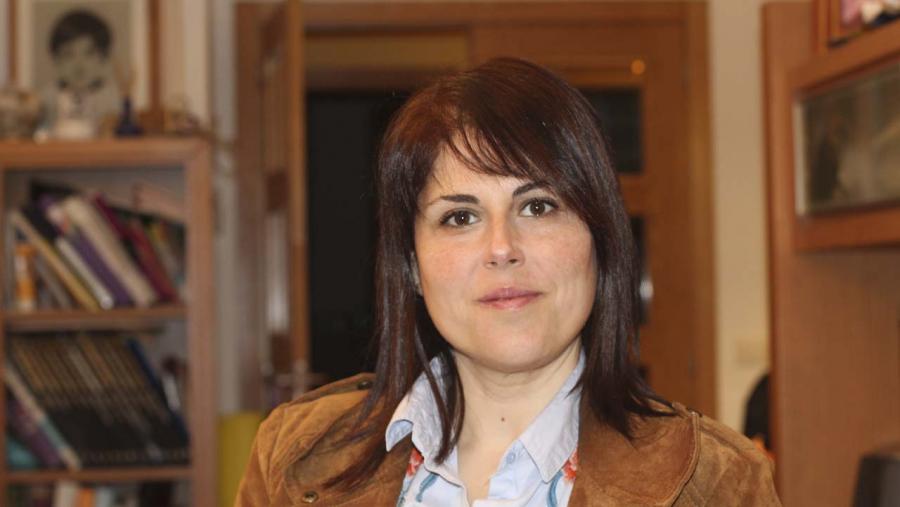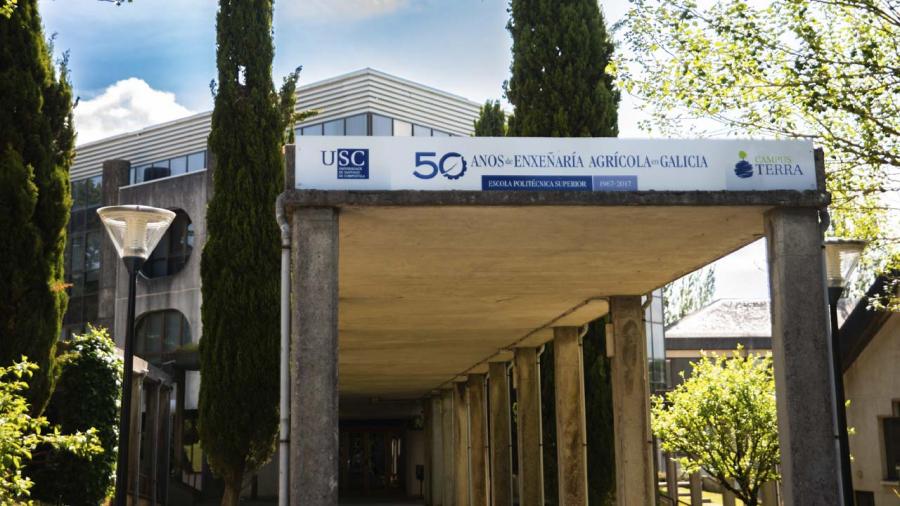María Dolores Fernández: «Society must have more information about the work that we, women, do»

Make visible. Change. Advance. There is much to do in the world today in the field of equality. In the case of engineering and STEM careers, the challenge is especially great. That is why today, on the occasion of 8M, we decided to speak with María Dolores Fernández Rodríguez, the doctor in Agricultural Engineering from the University of Santiago de Compostela, teacher, and researcher at Campus Terra and president of the Gender Equality Commission of the Higher Polytechnic Engineering School.
We talked with her about the stereotypes and social, economic, and administrative obstacles that constitute a barrier to increasing the number of women engineers, about the challenges posed by this historical moment, and about the work of the commission she chairs.
In the interview, there is also space to analyze her work as a teacher and researcher in fields such as energy efficiency and the sustainability of sectors such as agriculture and livestock.
Spend a few minutes on it, it's very worth it...
-In 2003 you became a doctor in Agricultural Engineering from the University of Santiago de Compostela. Two decades later… Do you think there have been great advances in terms of equality in this sector? Are there more female references today?
-In these more than 20 years many things have changed in equality. From my point of view, the most relevant is the awareness of the existence of inequality and the adoption of certain corrective measures. We go from moments in which equality was supposed to have already been acquired to a much deeper analysis supported by figures that reveal to us the reality in which inequality based on gender is a pattern present in our society and even more so in research.
Access to research contracts is extremely competitive and, until recently, maternity or paternity leave was not considered, which left women out. The question is: Why don't you leave men out when they become fathers? Society as a whole has to change.
In terms of references, there is much greater social interest and efforts are being made to make visible the excellent women who developed essential roles in science and technology, which we hope will serve to pave the way for new generations.
-When the percentage of male and female students in the classrooms is observed, notable differences can still be seen in STEM careers. What measures can be taken to attract more female talent?
-When it is indicated that notable differences can still be seen, that “still” manifests a false perception that we are improving towards equality between women and men in STEM careers.
While that is true in the case of science and mathematics majors, it is not true in the case of Technology and Engineering. In the latter, on which I can focus, although there is a wide range, the current figures are very similar to the figures from the 90s, they improved until the construction crisis around 2010 and have not yet recovered the previous values.
I think that the measures must be accompanied by making visible the work of women in STEM careers, including engineering, of their worth, of their strength in these essential careers. Society must have more information about the work that we, women, do, together with the knowledge of our careers, which is often small. What is engineering? Who can answer that question?
Only through knowledge will we be free to choose, and in secondary schools this work must be addressed to achieve greater inclusion of women in future job options with good job expectations, such as engineering.
-What are the main challenges that women engineers must face?
-First, say that, from a strictly engineering work point of view, the challenge is identical to that of men, there being no difference in the abilities to address them. Specifically, the fact of being a minority already represents a disadvantage in itself, in the democratic processes themselves, or in the practical non-existence of the social image of an engineer, which can represent an obstacle at the beginning of an employment relationship.
Many women use the term engineer to define their profession or use only their initials to sign. The professional associations themselves use the word engineer in their designation, instead of engineering. The paternalistic attitude is still present on the part of colleagues or superiors, who provide protection that women must overcome in many cases to advance in professional careers.
I might add that bureaucratic tasks without recognition are more often taken on by women, while those of representation, and therefore with social or economic recognition, are more easily taken on by men. In fact, the presence in managerial positions and at the top of professional careers is still reserved primarily for men.
These situations, which are typical of deeply masculinised professions, are probably due to the social structure and institutions that require us to carry the burden of care in the domestic sphere or do not consider us for coordination, management or command activities, and even censure us if we show ambitions that are considered legitimate for men, which affects all women, in all sectors. Breaking down the barriers of prejudice is the main challenge, which goes hand in hand with making the work of women engineers more visible.

-You have been president of the Gender Equality Commission of the Higher Polytechnic Engineering School since 2017. In these years, what initiatives were carried out to promote equality inside and outside the classrooms?
-The Gender Equality Commission of the Higher Polytechnic Engineering School is very active, which is the result of the group that constitutes it. From the commission, we assume giving visibility to female engineers is the main point.
I will point out two main actions, which are the workshop program to make female engineers visible in ESO centers with the designation “Protagonistas, as enxeñeiras” in collaboration with Campus Terra and the Lugo City Council, which began in 2018 and we resume this course with the visit of the IES Anxel Fole to the School on February 6 on the occasion of the Day of Women and Girls in Science in which more than 20 women engineers and engineering students participated; and the “TFG Enxeñaría e Muller Rural Awards”, of which we are already in the VIII edition and which yesterday we presented to three engineers, graduated students, for our 8M celebration. In this case, we focus on the projects and studies that engineers carried out to graduate.
In addition, we collaborate with all the Campus Gender Equality commissions in the commemoration or celebration of days such as 15L, 25N, 11F, and 8M, while we are in contact with the CienciaNOSA research group, which transfers pioneering women to which we try to give greater projection within our field, and with the Linguistic Normalization Commission with which we have organized activities. All these activities resulted in the granting, in 2019, by the City Council of Lugo, of the “Entre mulleres” award for this commission.
-Looking to the future, what objectives will mark the Commission's agenda in the coming years?
-Our idea is to continue with the actions we are carrying out: Protagonistas as enxeñeiras and Ingeniería e Muller Rural, which are future projects linked to giving prominence and light to the work of female engineers, providing nearby references in our field.
We intend to continue working for equality, continuing with fair demands that make a better and more inclusive society, always open to the needs of women, particularly in our center. We believe that making women visible and giving a voice is crucial and that is the path we want to continue traveling.
-As far as your teaching and research activity is concerned, you are a member of the BioMODEM research group, which you coordinated for more than five years. What role do sustainability, energy efficiency, or the circular economy play in agriculture and the development of the rural world?
-We inherited productive systems based on the overexploitation of natural resources to improve productivity and we are suffering the consequences that these systems produce in the environment.
Therefore, we are faced with the need to redefine the production model with two fundamental objectives. First, provide fair remuneration for the dignified work of food production, the main vocation of rural areas, without giving up the provision of other services.
Second, and no less important, to improve the sustainability of production processes, so that this balance allows population to be established in rural areas while enhancing the figure of the farmer socially. Balancing these two aspects requires a change in the production model that necessarily involves improving energy efficiency in the agroforestry field, rationalizing inputs, and controlling polluting tensions without forgetting that this is the sector with the greatest capacity for capturing CO2 and improving the medium, so the possible ecosystem services that the sector can offer are of great social interest.
-Society is experiencing intense days due to the tensions between ranchers and farmers throughout Europe. From your point of view, how could we find common ground to mitigate these tensions?
-From my point of view, the regulations established by the EU outline a very desirable destiny, but it is not considered the starting point of many productive systems, nor does it think about the path to be taken, or about the people who have to do it.
I agree with the necessary measures to protect the environment, but it is the job of institutions to generate sustainable models with feasible techniques and encourage their implementation, always providing decent jobs for people in the agroforestry sector, which has to be compatible with the need for sustainable food for the population, which is increasing worldwide. This requires a large investment in research and transfer in the agroforestry environment that is not being carried out in the necessary amounts to be able to meet the demands that the Administration itself imposes.
-You also participated in various agreements and contracts with different institutions and companies. Many of them, focused on the pork sector. How can research improve animal welfare or farm sustainability?
-Let's think about an animal breeding farm during the first stage, which in pigs would correspond to animals from birth until they weigh about 18-20 kg. At this stage, well-being depends fundamentally on the environment inside the accommodation, that is, on the conditions of humidity, temperature, or concentration of gases such as CO2 and NH3.
Ideal conditions will be achieved through the use of ventilation systems to extract contaminants that originate in the accommodation and heating to provide heat to the offspring. As they are opposing installations, knowledge of the evolution of these variables throughout the cycle, the interaction between them, and the dynamics of the different air conditioning installations makes it possible to improve both energy efficiency, avoiding the losses of traditional systems, while at the same time improves animal welfare.
But for this, it is necessary to carry out research, to know the evolution, the effects of the variation in outside temperatures, and the effects of the growth of animals.
-What research projects are you currently working on?
-Currently, we continue working to improve energy efficiency, and animal welfare and reduce greenhouse gas (GHG) emissions from farms, for which we work hand in hand with interested ranchers. in improving its production, as well as with other research centers.
We are working on new methodologies for predicting gas concentration inside housing to improve animal welfare and evaluating GHG emissions from pig fattening farms to reduce them. Our collaboration with an operational group is also planned to determine the effects of biochar on GHG emissions both in the storage and application of cattle slurry.
